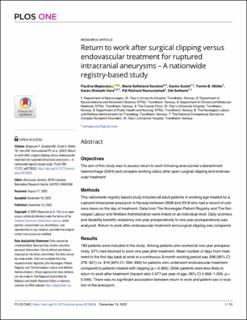| dc.contributor.author | Majewska, Paulina Luiza | |
| dc.contributor.author | Sandvei, Marie Søfteland | |
| dc.contributor.author | Gulati, Sasha | |
| dc.contributor.author | Müller, Tomm Brostrup | |
| dc.contributor.author | Hara, Karen Walseth | |
| dc.contributor.author | Romundstad, Pål Richard | |
| dc.contributor.author | Solheim, Ole | |
| dc.date.accessioned | 2023-02-08T13:46:25Z | |
| dc.date.available | 2023-02-08T13:46:25Z | |
| dc.date.created | 2022-12-28T20:36:05Z | |
| dc.date.issued | 2022 | |
| dc.identifier.issn | 1932-6203 | |
| dc.identifier.uri | https://hdl.handle.net/11250/3049374 | |
| dc.description.abstract | Objectives
The aim of this study was to assess return to work following aneurysmal subarachnoid haemorrhage (SAH) and compare working status after open surgical clipping and endovascular treatment.
Methods
This nationwide registry-based study included all adult patients in working age treated for a ruptured intracranial aneurysm in Norway between 2008 and 2018 who had a record of sickness leave on the day of treatment. Data from The Norwegian Patient Registry and The Norwegian Labour and Welfare Administration were linked on an individual level. Daily sickness and disability benefits recipiency one year preoperatively to one year postoperatively was analysed. Return to work after endovascular treatment and surgical clipping was compared.
Results
183 patients were included in the study. Among patients who worked at one year preoperatively, 57% had returned to work one year after treatment. Mean number of days from treatment to the first day back at work in a continuous 3-month working period was 298 (95% CI: 276–321) vs. 319 (95% CI: 299–339) for patients who underwent endovascular treatment compared to patients treated with clipping (p = 0.365). Older patients were less likely to return to work after treatment (hazard ratio 0.977 per year of age, 95% CI 0.956–1.000, p = 0.046). There was no significant association between return to work and patient sex or location of the aneurysm.
Conclusions
Aneurysmal SAH profoundly affects patient working status. This study found no significant difference in time to return to work after treatment between patients treated with endovascular techniques compared to patients undergoing open surgery. | en_US |
| dc.language.iso | eng | en_US |
| dc.publisher | PLOS, Public Library of Science | en_US |
| dc.rights | Navngivelse 4.0 Internasjonal | * |
| dc.rights.uri | http://creativecommons.org/licenses/by/4.0/deed.no | * |
| dc.title | Return to work after surgical clipping versus endovascular treatment for ruptured intracranial aneurysms - A nationwide registry-based study | en_US |
| dc.title.alternative | Return to work after surgical clipping versus endovascular treatment for ruptured intracranial aneurysms - A nationwide registry-based study | en_US |
| dc.type | Peer reviewed | en_US |
| dc.type | Journal article | en_US |
| dc.description.version | publishedVersion | en_US |
| dc.source.volume | 17 | en_US |
| dc.source.journal | PLOS ONE | en_US |
| dc.source.issue | 12 | en_US |
| dc.identifier.doi | 10.1371/journal.pone.0278528 | |
| dc.identifier.cristin | 2097854 | |
| dc.source.articlenumber | e0278528 | en_US |
| cristin.ispublished | true | |
| cristin.fulltext | original | |
| cristin.qualitycode | 1 | |

